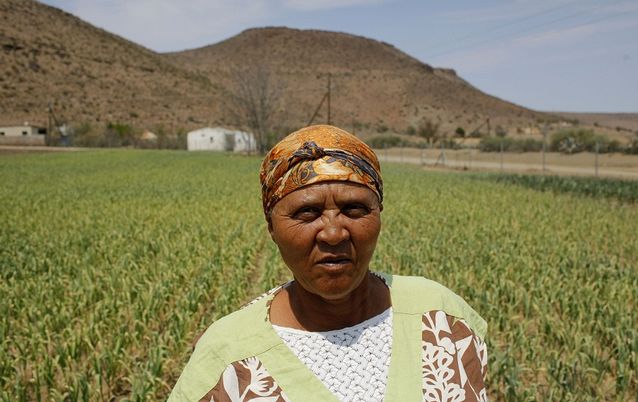WITH the end of apartheid, it was anticipated that a key element of state-making would be, among others, the restoration of the land rights of black citizens. However, after two decades of democracy, SA’s market-based land and agrarian reforms have failed spectacularly.
Very little land has been transferred to the historically marginalised black population, while rural poverty and unemployment have increased considerably.
In 1994, white farms occupied 85.8-million hectares, 86% of rural land. And about 15-million people, about half of the African population, lived on some 14-million hectares in the bantustans.
By 2010, about 4-million hectares of land had been transferred under the three-pronged land reform programme of redistribution, restitution and tenure reform. By 2014, the figures had hardly changed, demonstrating the failure of SA’s market-based land reforms.
The dualistic agrarian structure, dominated by a few white landowners, remains in place, while landlessness and rural poverty persist in the former bantustans and the urban periphery.
The government initially targeted poor households earning less than R1,500 per month under the settlement and land-acquisition grant. Between 1994 and 1999, a grant of R16,000 was provided to poor households earning less than R1,500 per month.
A review of the programme concluded that the limited involvement of the Department of Agriculture undermined the success of redistribution projects aimed at supporting agricultural production and that projects undertaken by large groups had a high failure rate in terms of income generation.
The Land Redistribution for Agricultural Development programme was introduced in 2001 to tackle some of the challenges including the lack of own contribution, which made it difficult successfully to screen applicants, and the exclusion of so-called emerging commercial farmers due to the use of a mandatory means test.
It was more focused on creating a class of black commercial farmers and favoured small groups based on households.
The programme was replaced in 2009 by the Proactive Land Acquisition Strategy (Plas). Rural Development and Land Reform Minister Gugile Nkwinti says Plas was adopted to "ensure that we rekindle the class of black commercial farmers that was disrupted by the 1913 Natives Land Act".
The department allocated R204m to emerging farmers to upgrade the infrastructure on their land. Under Plas, the state leased land to beneficiaries and the department facilitated strategic partnerships between white commercial farmers and land-reform beneficiaries.
Those who failed in their agricultural enterprises risked repossession of their land under the "use it or lose it" principle. In this way, government policy perpetuated tenure insecurity among land reform beneficiaries.
Research in Limpopo shows that under the Plas programme, the Department of Rural Development and Land Reform sought to exercise control over beneficiaries’ land-use models and agricultural activities.
This undermined agricultural investment and productivity, as the beneficiaries felt insecure with tenure arrangements under which the state exercised undue influence over their activities.
...
EMPIRICAL data gathered in Levubu, Limpopo show that the rents and dividends paid to land reform beneficiaries were negligible, while white managers received large salaries.
Similarly, strategic partnerships at the Levubu and Moletele projects in Limpopo failed to improve incomes or job creation. Another assessment of 39 land reform projects in Limpopo shows that such projects had "caused an 89.5% decrease in production, as well as many job losses".
However, not all land-reform projects have failed. In the Eastern Cape, data showed that some succeeded, especially where a strong sense of ownership and cohesion existed among the beneficiary group.
The government’s attitude towards emerging black farmers seems to be influenced by colonial-era stereotypes of African agriculture as backward and unproductive.
While the expertise of white farmers can be deployed to support "emerging farmers", some have sought to profit from land-reform projects.
In Limpopo, Portion 40 changed hands twice in 1998. First, it was bought by the Boet Booysen Trust, before being sold in the same year for R380,000 to Coastal and Inland Investment, which sold the farm in 2000 to Aanbreek Beleggings for R325,000.
Portion 40 was then sold in 2007 to the government for R2.15m. In 2009, the farm was transferred to the Elangeni Family Trust for R2.15m.
Although it is not clear what improvements were made to the farm, the price hike illustrates how market-led agrarian reform policies have skewed the land market in favour of landowners. They have used their status as "experts", with beneficiaries of land reform often being coerced by the government to enter into land-management contracts with white former landowners.
Ironically, landowners have been the major beneficiaries of land reform. This has undermined the democratisation of the South African agrarian structure.
The problem lies in the ambiguity of the land-reform policies. On the one hand, they seek to maintain the large farms inherited from apartheid; on the other, they seek to redistribute land and tackle historical injustices. This creates contradictions in the implementation of land reform.
The continued dominance of large farms, due to the post-apartheid consolidation of farms by transnational agribusinesses, presents barriers for new African entrants to farming. They are expected to compete with these well-established agribusinesses without the benefit of prior state support. White farmers relied on state support for their survival until the agricultural sector was liberalised in the 1990s in anticipation of the end of apartheid.
Retailers, along with other agribusinesses, emerged as major players dominating the agricultural output markets. Four companies — Shoprite, Pick n Pay, Spar and Woolworths — handle 50%-60% of all food retail in SA. Agribusiness prefers to procure from larger companies with the necessary capital to meet the supermarkets’ procurement requirements. This makes it difficult for smallholder farmers to access agricultural markets and the supply chain.
While it is important to maintain farm productivity during the land-transfer process, redistributive land reform must fundamentally restructure agrarian relations in favour of the poor. This should inevitably involve dismantling the large farms or reducing their size, in favour of a more democratic trimodal agrarian structure.
...
THERE are more financial challenges to sustaining big farms than for small producers, as evidenced by bankruptcies facing many white commercial farmers. Thus, the government should promote the growth of the smallholder farming sector rather than the large farms it now favours.
The government should also support the development of technologies that suit small farmers, taking into consideration local and indigenous knowledge. Most imported technologies in the past favoured mass production of export crops by big agribusiness, and contributed to land degradation and job shedding.
It has been argued that once poor people are given good farmland, they can lift themselves out of poverty permanently — even without significant government support, and that countries undergoing unsuccessful land reform (such as SA) tend to have high levels of rural poverty.
In countries with successful land reform in favour of smallholders, such as China, Costa Rica, Indonesia, Malaysia, Taiwan and Thailand, rapid economic growth has been witnessed that challenges the myth that smallholder farmers cannot farm productively.
In some sectors, redistributive land reform has been opposed on the pretext that it leads to food insecurity. Yet, in many countries that have redistributed land rights to peasants, food production has risen, and local economies and employment have improved.
Even in Zimbabwe, with its controversial fast-track land reform, peasant farmers have made significant investments in their newly acquired land and rural livelihoods have been diversified.
In SA, this is likely to lessen the fiscal burden faced by the government, because of the large numbers of rural households that are dependent on social grants for their livelihoods.
SA’s land reforms have failed to restructure agrarian relations in favour of the landless poor. This is a direct cause of poverty and injustice.
There is a need to rethink land-reform approaches by considering a more redistributive process that could bring about the equity and efficiency that is long overdue in the sector.
• This is an edited extract from a chapter on land and agrarian reform that appears in the 2015 Transformation Audit, published by the Institute for Justice and Reconciliation

Garlic farmer Molly Nikelo walks through her fields in Nieu-Bethesda in the Eastern Cape. Data from the province show that land-reform projects are more likely to succeed where a strong sense of ownership and cohesion exists in the beneficiary group. Picture: REUTERS
WITH the end of apartheid, it was anticipated that a key element of state-making would be, among others, the restoration of the land rights of black citizens. However, after two decades of democracy, SA’s market-based land and agrarian reforms have failed spectacularly.
Very little land has been transferred to the historically marginalised black population, while rural poverty and unemployment have increased considerably.
In 1994, white farms occupied 85.8-million hectares, 86% of rural land. And about 15-million people, about half of the African population, lived on some 14-million hectares in the bantustans.
By 2010, about 4-million hectares of land had been transferred under the three-pronged land reform programme of redistribution, restitution and tenure reform. By 2014, the figures had hardly changed, demonstrating the failure of SA’s market-based land reforms.
The dualistic agrarian structure, dominated by a few white landowners, remains in place, while landlessness and rural poverty persist in the former bantustans and the urban periphery.
The government initially targeted poor households earning less than R1,500 per month under the settlement and land-acquisition grant. Between 1994 and 1999, a grant of R16,000 was provided to poor households earning less than R1,500 per month.
A review of the programme concluded that the limited involvement of the Department of Agriculture undermined the success of redistribution projects aimed at supporting agricultural production and that projects undertaken by large groups had a high failure rate in terms of income generation.
The Land Redistribution for Agricultural Development programme was introduced in 2001 to tackle some of the challenges including the lack of own contribution, which made it difficult successfully to screen applicants, and the exclusion of so-called emerging commercial farmers due to the use of a mandatory means test.
It was more focused on creating a class of black commercial farmers and favoured small groups based on households.
The programme was replaced in 2009 by the Proactive Land Acquisition Strategy (Plas). Rural Development and Land Reform Minister Gugile Nkwinti says Plas was adopted to "ensure that we rekindle the class of black commercial farmers that was disrupted by the 1913 Natives Land Act".
The department allocated R204m to emerging farmers to upgrade the infrastructure on their land. Under Plas, the state leased land to beneficiaries and the department facilitated strategic partnerships between white commercial farmers and land-reform beneficiaries.
Those who failed in their agricultural enterprises risked repossession of their land under the "use it or lose it" principle. In this way, government policy perpetuated tenure insecurity among land reform beneficiaries.
Research in Limpopo shows that under the Plas programme, the Department of Rural Development and Land Reform sought to exercise control over beneficiaries’ land-use models and agricultural activities.
This undermined agricultural investment and productivity, as the beneficiaries felt insecure with tenure arrangements under which the state exercised undue influence over their activities.
...
EMPIRICAL data gathered in Levubu, Limpopo show that the rents and dividends paid to land reform beneficiaries were negligible, while white managers received large salaries.
Similarly, strategic partnerships at the Levubu and Moletele projects in Limpopo failed to improve incomes or job creation. Another assessment of 39 land reform projects in Limpopo shows that such projects had "caused an 89.5% decrease in production, as well as many job losses".
However, not all land-reform projects have failed. In the Eastern Cape, data showed that some succeeded, especially where a strong sense of ownership and cohesion existed among the beneficiary group.
The government’s attitude towards emerging black farmers seems to be influenced by colonial-era stereotypes of African agriculture as backward and unproductive.
While the expertise of white farmers can be deployed to support "emerging farmers", some have sought to profit from land-reform projects.
In Limpopo, Portion 40 changed hands twice in 1998. First, it was bought by the Boet Booysen Trust, before being sold in the same year for R380,000 to Coastal and Inland Investment, which sold the farm in 2000 to Aanbreek Beleggings for R325,000.
Portion 40 was then sold in 2007 to the government for R2.15m. In 2009, the farm was transferred to the Elangeni Family Trust for R2.15m.
Although it is not clear what improvements were made to the farm, the price hike illustrates how market-led agrarian reform policies have skewed the land market in favour of landowners. They have used their status as "experts", with beneficiaries of land reform often being coerced by the government to enter into land-management contracts with white former landowners.
Ironically, landowners have been the major beneficiaries of land reform. This has undermined the democratisation of the South African agrarian structure.
The problem lies in the ambiguity of the land-reform policies. On the one hand, they seek to maintain the large farms inherited from apartheid; on the other, they seek to redistribute land and tackle historical injustices. This creates contradictions in the implementation of land reform.
The continued dominance of large farms, due to the post-apartheid consolidation of farms by transnational agribusinesses, presents barriers for new African entrants to farming. They are expected to compete with these well-established agribusinesses without the benefit of prior state support. White farmers relied on state support for their survival until the agricultural sector was liberalised in the 1990s in anticipation of the end of apartheid.
Retailers, along with other agribusinesses, emerged as major players dominating the agricultural output markets. Four companies — Shoprite, Pick n Pay, Spar and Woolworths — handle 50%-60% of all food retail in SA. Agribusiness prefers to procure from larger companies with the necessary capital to meet the supermarkets’ procurement requirements. This makes it difficult for smallholder farmers to access agricultural markets and the supply chain.
While it is important to maintain farm productivity during the land-transfer process, redistributive land reform must fundamentally restructure agrarian relations in favour of the poor. This should inevitably involve dismantling the large farms or reducing their size, in favour of a more democratic trimodal agrarian structure.
...
THERE are more financial challenges to sustaining big farms than for small producers, as evidenced by bankruptcies facing many white commercial farmers. Thus, the government should promote the growth of the smallholder farming sector rather than the large farms it now favours.
The government should also support the development of technologies that suit small farmers, taking into consideration local and indigenous knowledge. Most imported technologies in the past favoured mass production of export crops by big agribusiness, and contributed to land degradation and job shedding.
It has been argued that once poor people are given good farmland, they can lift themselves out of poverty permanently — even without significant government support, and that countries undergoing unsuccessful land reform (such as SA) tend to have high levels of rural poverty.
In countries with successful land reform in favour of smallholders, such as China, Costa Rica, Indonesia, Malaysia, Taiwan and Thailand, rapid economic growth has been witnessed that challenges the myth that smallholder farmers cannot farm productively.
In some sectors, redistributive land reform has been opposed on the pretext that it leads to food insecurity. Yet, in many countries that have redistributed land rights to peasants, food production has risen, and local economies and employment have improved.
Even in Zimbabwe, with its controversial fast-track land reform, peasant farmers have made significant investments in their newly acquired land and rural livelihoods have been diversified.
In SA, this is likely to lessen the fiscal burden faced by the government, because of the large numbers of rural households that are dependent on social grants for their livelihoods.
SA’s land reforms have failed to restructure agrarian relations in favour of the landless poor. This is a direct cause of poverty and injustice.
There is a need to rethink land-reform approaches by considering a more redistributive process that could bring about the equity and efficiency that is long overdue in the sector.
• This is an edited extract from a chapter on land and agrarian reform that appears in the 2015 Transformation Audit, published by the Institute for Justice and Reconciliation
























Change: 1.19%
Change: 1.36%
Change: 2.19%
Change: 1.49%
Change: -0.77%
Data supplied by Profile Data
Change: -0.19%
Change: 0.69%
Change: 1.19%
Change: 0.00%
Change: 0.44%
Data supplied by Profile Data
Change: 0.62%
Change: 0.61%
Change: 0.23%
Change: 0.52%
Change: 0.12%
Data supplied by Profile Data
Change: -0.21%
Change: -1.22%
Change: -0.69%
Change: -0.51%
Change: 0.07%
Data supplied by Profile Data